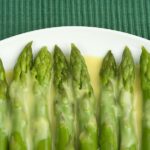Potatoes are not fattening.
Potatoes are high in fiber content and contain quality complex carbohydrates that will fill you up but not fill you out. A medium-sized baked potato contains around 90 calories, about the same as an apple.
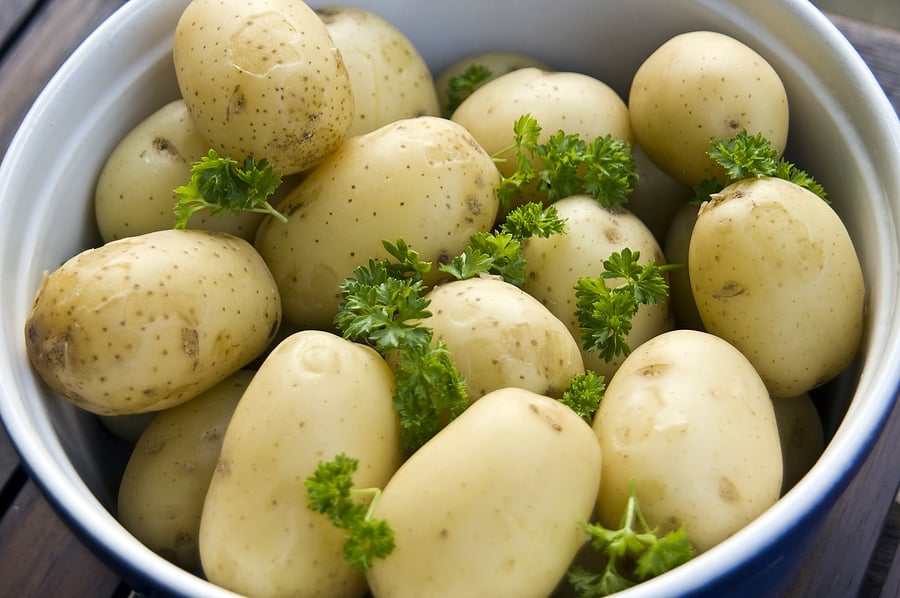
However, potatoes drenched in butter or smothered in gravy or the fat in the steak you eat with potatoes will thicken your waist.
Favorite potato recipes
How to Make Seasonal and Flavorful Potato Salad
Ham, Potato, and Cheese Gratin
Yellow Potato Side Dish and Soup
New potatoes and maincrop potatoes
- Potato varieties are often categorized by their harvest time: early (late spring), midseason (summer), and late-season (fall and winter) potatoes.
- There are two main potato crops grown each year: one for late summer harvesting—usually called new potatoes–and the second to store for winter use—usually called maincrop or mature potatoes.
- Mature potatoes can remain in the ground in regions where the ground does not freeze. Potatoes that are stored in the ground are harvested before they start growing again in the spring.
Kitchen Helpers from Amazon:
- Oster Vegetable Steamer
- Chef’s Knives Set of 6
- EZ Off Jar Opener for Weak Hands
- Pepper Core Remover Stainless Steel
- Kitchen Utensils – Set of 35
How to choose a potato
- Select firm, unblemished potatoes that show no sign of sprouting or green patches.
- Avoid potatoes that are wrinkled, cracked, soft, or spongy.
- Green patches on potatoes are caused by an alkaloid compound called solanine. Solanine develops when potatoes are exposed to light for long periods. Solanine can be toxic.
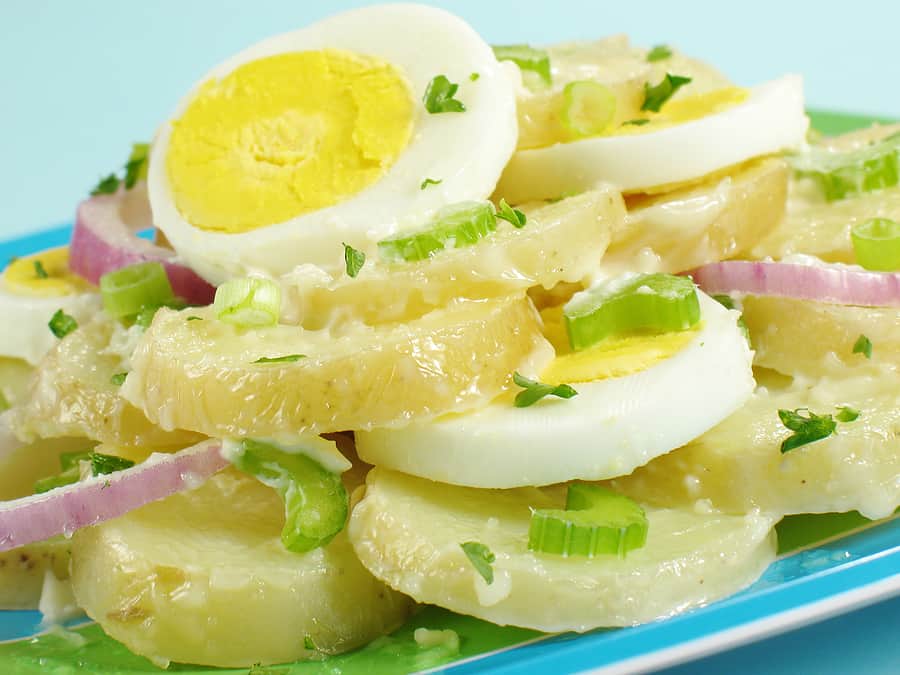
How to choose a potato for cooking
- Choose potatoes for the style of cooking you have in mind.
- Use high-starch potatoes for baking, frying, and mashing.
- Use medium starch potatoes for steaming, baking, roasting, grilling, and au gratin dishes.
- Use low-starch potatoes for boiling, roasting, grilling, sautés, stews, salads, and au gratin dishes.
- You can determine how starchy a potato is by cutting it with a knife. If the potato clings to the knife or if the knife is coated with a creamy white substance, the potato is starchy.
How to prep potatoes for cooking
- Green fleshed potatoes will be bitter and inedible. Cut out any green flesh. Cut out any “eyes” that are starting to sprout.
- Scrub potatoes that are to be cooked with their skin.
- You do not need to peel early or new potatoes. You can cook them after scrubbing.
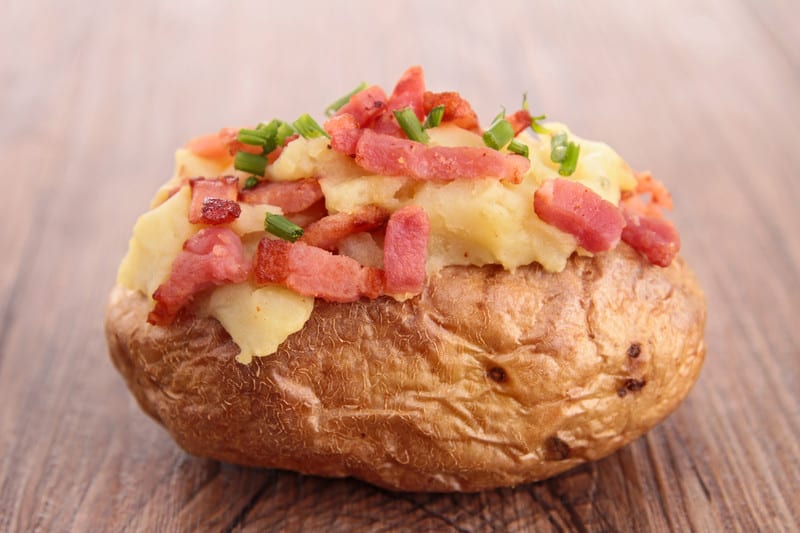
How to bake a potato
hoose potatoes the same size so that they will cook evenly. Scrub unpeeled, pierce each potato with a fork to allow moisture to escape during cooking, and place on an oven rack. For soft skin, rub each with butter or olive oil before baking. Test for doneness by squeezing potatoes with an oven mitt. If there is a slight give the potato is done. For fluffy flesh, slice an X on the top of each potato then pinch the end to force up the steamy flesh, roll, and steam will release and the potato will be fluffy. You can bake several potatoes at once by standing them up in a muffin pan.
- Use a baking potato; that is a potato high in starch.
- Preheat the oven to 450 degrees F.
- Rub the potatoes with olive or vegetable oil; sprinkle it with salt. Prick the potato with the tines of a fork.
- Place the potato on a baking sheet or lay it directly on the oven rack,.
- Bake for 45 to 60 minutes (depending on size); turn the potato once at halfway.
- Bake until the skin is golden and crispy; the potato will be baked when a knife inserted in the flesh meets no resistance. The internal temperature should be about 210 degrees F.
How to bake a potato in a slow cooker
- Wrap an oiled and salted potato in foil, then cook on low for 8 to 10 hours.
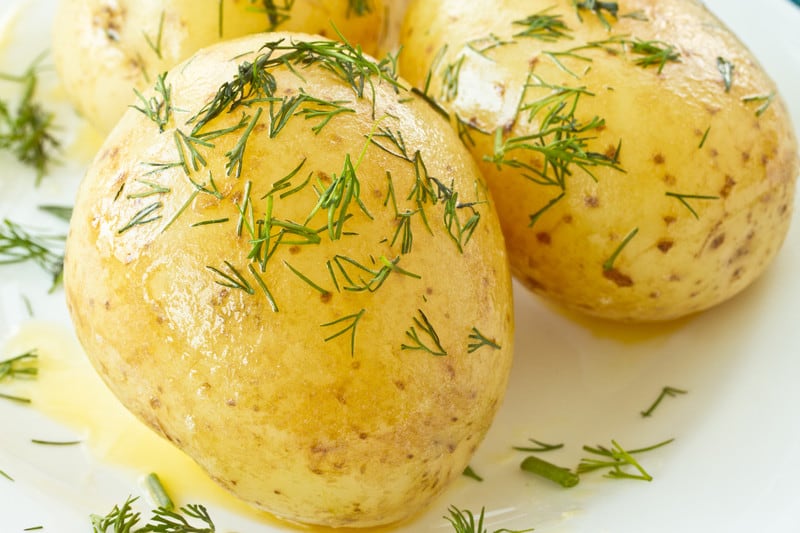
How to boil a potato
Cover in a small amount of salted water, and bring to a boil for 20 to 25 minutes or until tender.
- Boil potatoes with the skin intact if the potato is the size of a golf ball or smaller. Peel and quarter larger potatoes.
- Boil in well-salted water (salted water will make the potato tastier) until tender, that is until a sharp knife can pierce the potato with little resistance.
- Drain the water and set the potatoes in a colander to dry. Potatoes will continue to cook for a bit after they are out of the boiling water.
- Serve hot with melted butter and minced herbs, or drizzled with olive oil and lemon zest.
- Boiled potatoes can sit at room temperature for nearly an hour before the flavor and texture start to deteriorate.

How to make mashed potatoes
Choose high-starch potatoes roughly the same size. Boil with skins intact until tender; drain; they will be easy to peel after cooking; add butter or warm milk or cream; mix with a wooden spatula. For lighter mashed potatoes, increase the mixing time and quantity of milk or cream added.
- Peel two large potatoes per person and cut them into large chunks.
- Bring a large pot of water to a boil; add a tablespoon of salt for each gallon of water.
- Boil the potatoes until tender all the way through; begin testing for tenderness after 10 minutes.
- While the potatoes are boiling heat added flavorings such as milk, cream, butter, buttermilk, or stock
- Remove tender potatoes with a slotted spoon and let them drain in a colander. Reserve a cup of cooking water.
- Return potatoes to the pot. Place over low heat and shake until most of the steam has dissipated.
- Add hot or warm flavorings, mash, and taste. Add salt to taste. Repeat until mashed and seasoned to your liking. Adjust the texture with cooking water.
- Serve immediately or cover tightly in a ceramic bowl and set aside for up to 30 minutes. To reheat cold mashed potatoes set the bowl inside a pot partially filled with water and simmer until the potatoes are warm again.
Mashed potato add-ons
- Add another root vegetable to the mash. Try these combinations: ⅔ mashed celery root to ⅓ mashed potato; ½ mashed turnips or parsnips to ½ mashed potato; ½ mashed cauliflower to ½ mashed potato.
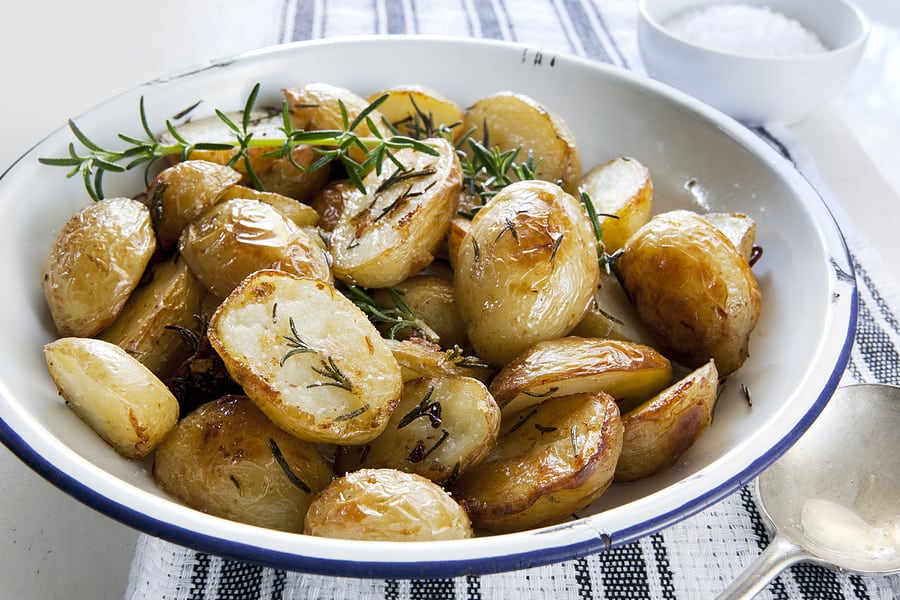
How to roast potatoes
Boil small, all-purpose, or low-starch potatoes with skin intact. After, cut potatoes into even-size chunks. Toss with olive oil, salt, and ground black pepper, and spread the cut side down on a baking sheet. Roast in 425ºF oven. Stir until crisp and golden.
- New potatoes can be roasted whole and raw. Mature, starchy potatoes should be precooked in boiling water or in the microwave.
- New potatoes are best roasted with the skin on. Mature potatoes can be roasted with the skin on or peeled. Cut matures potatoes into thick wedges.
- Precook cut potatoes (not baby or new potatoes) in a microwave until soft but still firm, about 4 minutes. Or boil in salted water until tender, about 10 minutes.
- Preheat the oven to 450 degrees F.
- Spread the potatoes on a pan or baking sheet. Drizzle the potatoes with olive oil or fat and toss well. The potatoes should be evenly coated and the pan should have light, even oil across the surface.
- Season with salt, dry herbs, or spices.
- Roast 20 to 30 minutes, until bottoms are browned and a spatula slides under them smoothly.
- Turn and keep roasting until done about 20 to 30 minutes.

How to pan fry potatoes
Peel or leave the skins on. Soak cut pieces in lemon water for about 15 minutes and dry thoroughly before frying. Fry until edges turn brown, drain, and then finish in a preheated oven at 250ºF for an evenly crisp serving.
- For pan-fried potatoes, use par-cooked (partially boiled) potatoes, peeled or unpeeled.
- Cut into slices between ¼ and ½-inch thick. High- or medium-starch potatoes such as ‘Idaho’ or ‘Yukon Gold’ are best (see How to Choose a Potato for Cooking above).
- Heat 2 tablespoons of vegetable oil in a wide skillet over medium heat.
- Add potatoes. Cook the potatoes in batches.
- Adjust the heat so that the potatoes sizzle but do not smoke.
- Add flavorings such as salt and pepper or paprika or minced onions.
- Turn with a spatula until browned and soft.
How to make French fries
- Peel large Idaho potatoes and cut them lengthwise into slices, ⅜ to ½ inch thick, keeping the slices together.
- Quarter turn the slices and cut slices into strips. Or cut potatoes into round slices, medium-sized chunks, or wedges.
- Soak the cut potatoes in cold water for at least 30 minutes or overnight. Drain potatoes and pat dry.
- Place the potatoes in a deep heavy pot and pour in vegetable oil to cover, plus an inch or two more.
- Heat the oil and potatoes to a simmer and cook slowly until very soft, for about 30 minutes. Stir occasionally to prevent sticking.
- Raise the heat to medium. Let the soft potatoes fry in bubbling oil until golden and crisp, another 10 to 15 minutes
- Remove the potatoes with a slotted spoon and place in a paper towel-lined bowl. Shake to drain.
- Remove the paper towels. Add salt, and shake again. Serve hot.
How to make potato gratin (scalloped potatoes) and casseroles
- Preheat the oven to 400 degrees F.
- Peel the potatoes and slice them up to 1/4-inch thick.
- Layer the potatoes in an ovenproof skillet almost to the top. Overlap the slices slightly nearly to the top of the skillet.
- Dot the top of the potatoes with 2 to 3 tablespoons of butter, and cut them into chunks. Pour in half-and-half (or a combination of milk and cream) to come 3/4 of the way to the top (about 2 to 3 cups).
- Place the skillet on the stove and bring the liquid to a boil; reduce the heat and cook for 10 minutes, until the liquid level drops.
- Place the skillet in the oven and bake until the top browns, 10 minutes.
- Reduce the heat to 300 degrees F and garnish the top with grated cheese (Cheddar, Gruyère, Parmesan). Cook 10 minutes more or until tender and browned.
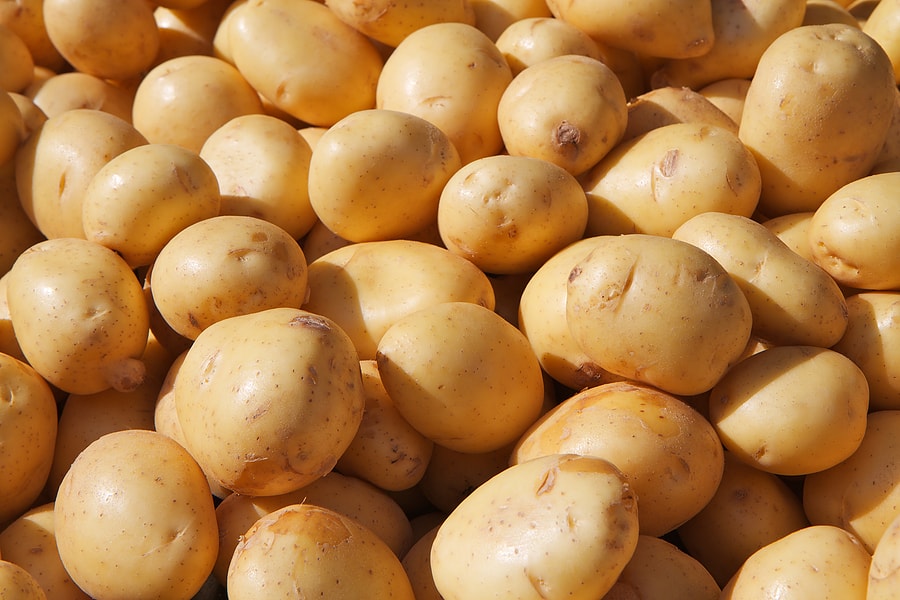
Yukon Gold potatoes
How to cook Yukon Gold potatoes
Yellow potatoes are well suited for boiling, steaming, mashing, roasting, grilling, and au gratin dishes. ‘Yukon Gold’ is a stand-out yellow potato with a buttery-tasting flesh that you will want to try mashed, steamed, in soups and chowders, or made into potato pancakes.
Because the ‘Yukon Gold’ brings its own buttery flavor to the table, you won’t need to add butter or margarine to ‘Yukon Gold’ dishes. Yellow potatoes like ‘Yukon Gold’ also require less seasoning than white potatoes.
The ‘Yukon Gold’ is slightly flat and oval with a thin, golden yellow skin. It has shallow eyes and golden-yellow flesh. You know you have a ‘Yukon Gold’ in your hand if the shallow eyes are a rosy pink color.
The ‘Yukon Gold’ has a lower starch content than the Idaho or russet which makes it a good all-purpose potato. Feel free to use the ‘Yukon Gold’ or other yellow potatoes in recipes that call for white potatoes.
Steamed. To steam the ‘Yukon Gold’ or other thin-skinned potatoes, arrange whole thin-skinned potatoes or ½-inch-thick slices on a steamer rack. Steam over 1 to 2 inches of boiling water until tender throughout when pierced (30 to 35 minutes for whole potatoes, 8 to 10 minutes for slices).
Mashed. For mashed ‘Yukon Gold’ potatoes (which some are the tastiest of all mashed potatoes): Cover the potatoes in an inch of water in a saucepan with ½ teaspoon of salt, bring to a boil, and then allow to simmer for 15 to 20 minutes until the potatoes are skewered easily. Drain, reserving some of the cooking water, and dry the potatoes in the saucepan over medium heat until the potatoes are floury. Use a hand masher until the potatoes are creamy smooth then beat in unsalted, softened butter and milk or buttermilk, and some of the reserved cooking water if need be, until the texture is just the way you like it. Season these mashed potatoes to taste with salt and pepper.
Because its sugar content is slightly higher than a russet, the ‘Yukon Gold’ does not store as well. Keep yellow potatoes at 40-50ºF (4-10ºC), but not below 33ºF (1ºC). Keep potatoes in a paper bag in the refrigerator vegetable crisper away from onions. Yellow potatoes are best used within a week. If you keep potatoes in a cool, dark, well-ventilated area, they will keep longer.
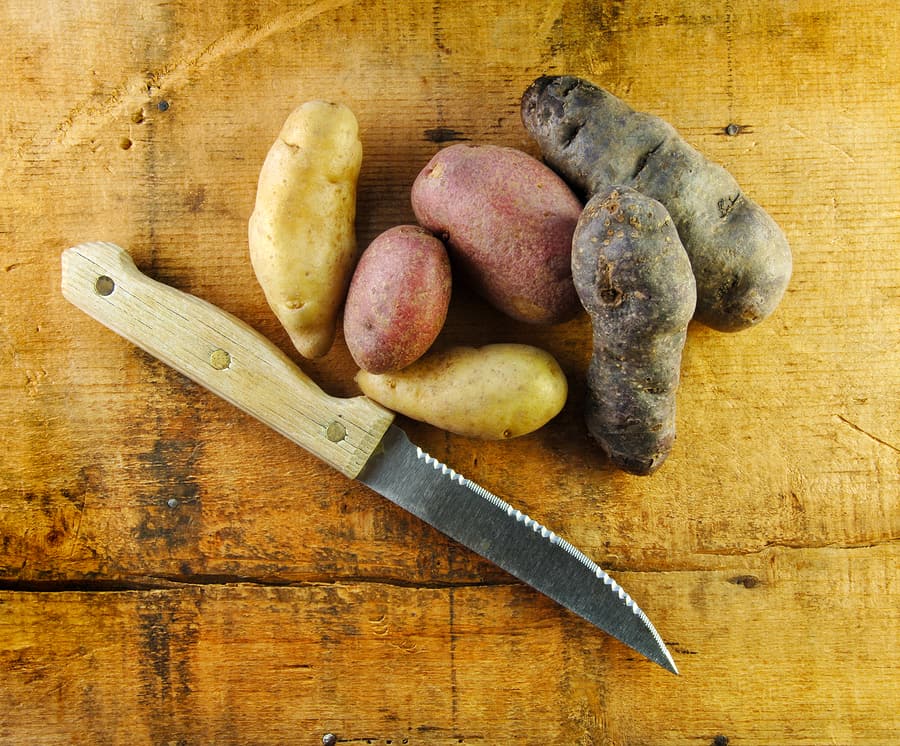
More ways to cook potatoes
Simmer. Round white potatoes can be simmered whole. Larger potatoes should be cut into halves, quarters, or thick slices. Place them in cold water. Cook for 15 to 30 minutes, depending on size, until they can be pierced to the center with a paring knife.
Steam. Place potatoes over boiling water, and use a metal steamer or a colander. Place it over a few inches of water in a 2- or 3-quart saucepan with a tight-fitting lid. Bring the water to a boil, add the potatoes, and steam until crisp-tender.
Wrap-steam. Wrap each potato in aluminum foil. Bake at 400ºF for about 50 to 60 minutes. Turn each potato every 15 to 20 minutes so that they cook evenly. The flesh will be dense and gummy.
Stuff. Bake or wrap-steam the potato whole as described above. Then cut it in half lengthwise. Scoop out the flesh leaving a thin layer of flesh to help the skin hold its shape. Mix the flesh with other fully cooked ingredients such as cooked meats or vegetables or pieces of cheese or any combination of these.
More ways to serve potatoes
- Season potatoes with salt, pepper, onion, garlic, dill, basil, oregano, mustard seed, caraway seed, celery seed, bay leaf, parsley, sage, rosemary, or thyme.
- Serve baked potatoes topped with flavored butter or margarine, sour cream, or plain yogurt, chives, grated or melted cheese or cheese sauce, stewed tomatoes, tomato sauce, white sauce, cooked bacon, ham or mushrooms or a combination of these.
- You can boil, steam, bake, fry, mash, roast, sauté, or cook potatoes au gratin. Potatoes must be served cooked because they contain high levels of indigestible starch. That starch is converted to sugar during cooking.
- Potatoes can accompany meats, poultry, and fish. They are featured in aligot, goulash, Swiss rösti, and Irish stew. Add potatoes to soups, stews, soufflés, and omelets. Potatoes are an essential ingredient in croquettes, quenelles, and gnocchi.
- Potato starch is used in the making of pastries, cold meats, and pudding, and as a thickening agent.
- Boil new potatoes for 12 minutes with a spring of mint; drain, toss in butter, eat cold or hot in salads.
- Bake and serve a whole potato with butter and or sour cream.
- Stuff baked potatoes with tuna and spinach.
- Slice thin and sauté or grate and sauté potatoes to make hash browns.
- Cook cubed and sautéed potatoes with onion and green pepper and serve with breakfast eggs.
- Add cubed, cooked potatoes with other vegetables to an omelet or frittata.
- For light and fluffy mashed potatoes, use hot milk–not cold–or add a teaspoon of baking powder.
- Mash potatoes with another puréed vegetable such as celeriac, chestnuts, or parsnips.
- Cut potatoes into ½ inch (1.3 cm) strips, wash in cold water, drain, dry, fry until golden brown in a shallow frying basket in a pan one-third full of oil at 250ºF (121ºC).
Also of interest: How to Cook Potatoes With No Recipe
Potato flavor partners
- Potatoes have a flavor affinity for butter, chicken, herbs, mayonnaise, olive oil, onions, pork, salads, shallots, and vinaigrette.
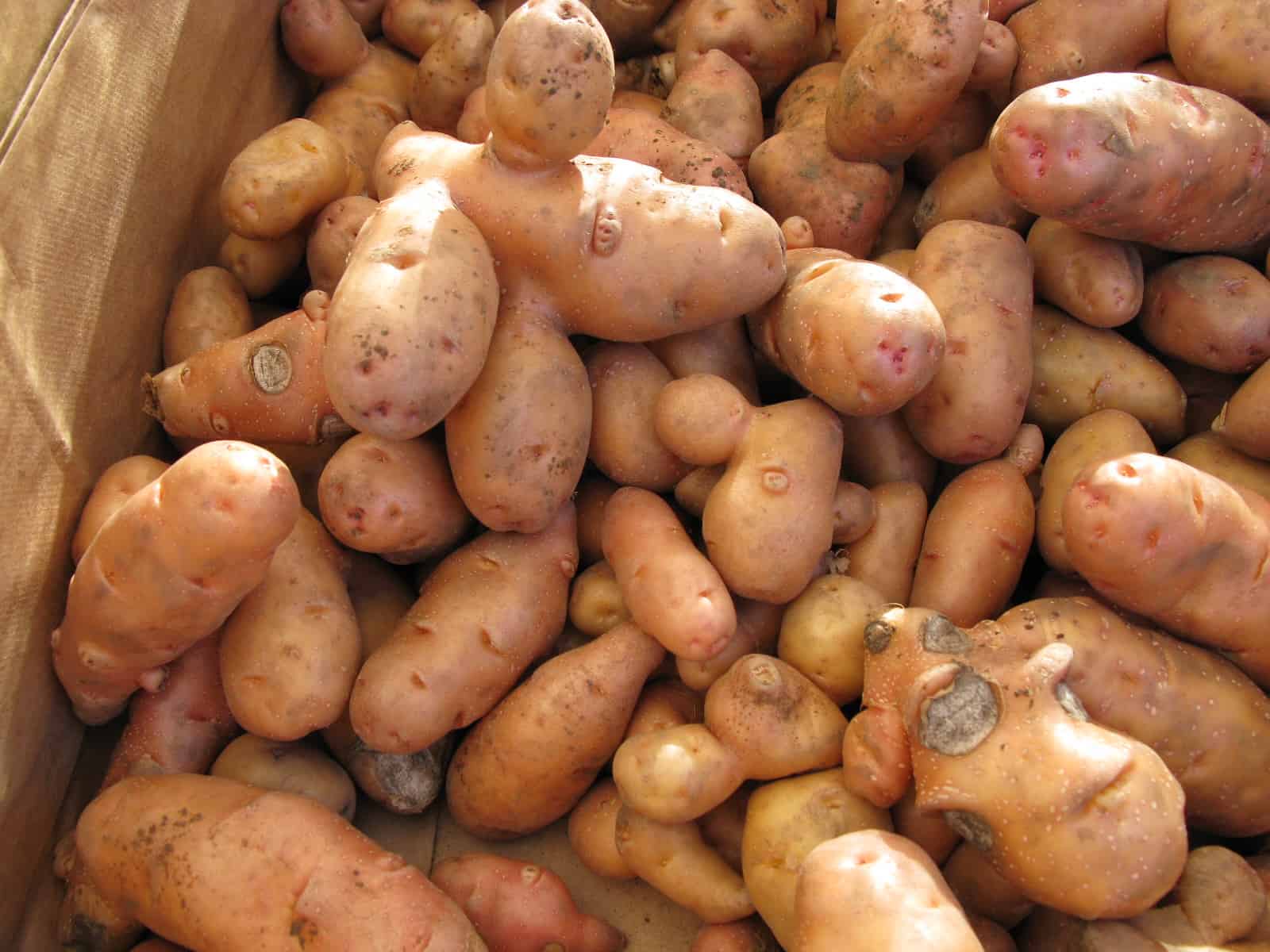
How to store potatoes
- Potatoes should be dried or cured before they are stored. Cure potatoes for a period of 4 to 5 days at 60-70ºF (16-21°C) in high humidity; this will allow cuts and surface injuries of the tuber to “heal.” Afterward curing potatoes, store them in a cool, dark, well-ventilated area for up to 6 months.
- Well-matured potatoes without defects are the best keepers. Store them in a paper bag, not plastic—which allows the moisture to escape and protects the tubers from light.
- Use new potatoes within a week of purchase. Prepared or new potatoes freeze well.
Potato nutrition
- Potatoes are a good source of vitamins B and C and minerals—most of which are located in the skin or immediately below the skin.
- Potatoes are high in carbohydrates and low in sodium.
- A medium-sized boiled potato contains 76 calories; a larger baked potato contains 139.
Potato health warning
- When potato tubers are exposed to light, an alkaloid, solanine, forms. The amount depends on the length of exposure, intensity, and quality of light.
- Solanine tastes bitter, and the ingestion of large amounts of solanine can cause sickness and in extreme cases, death.
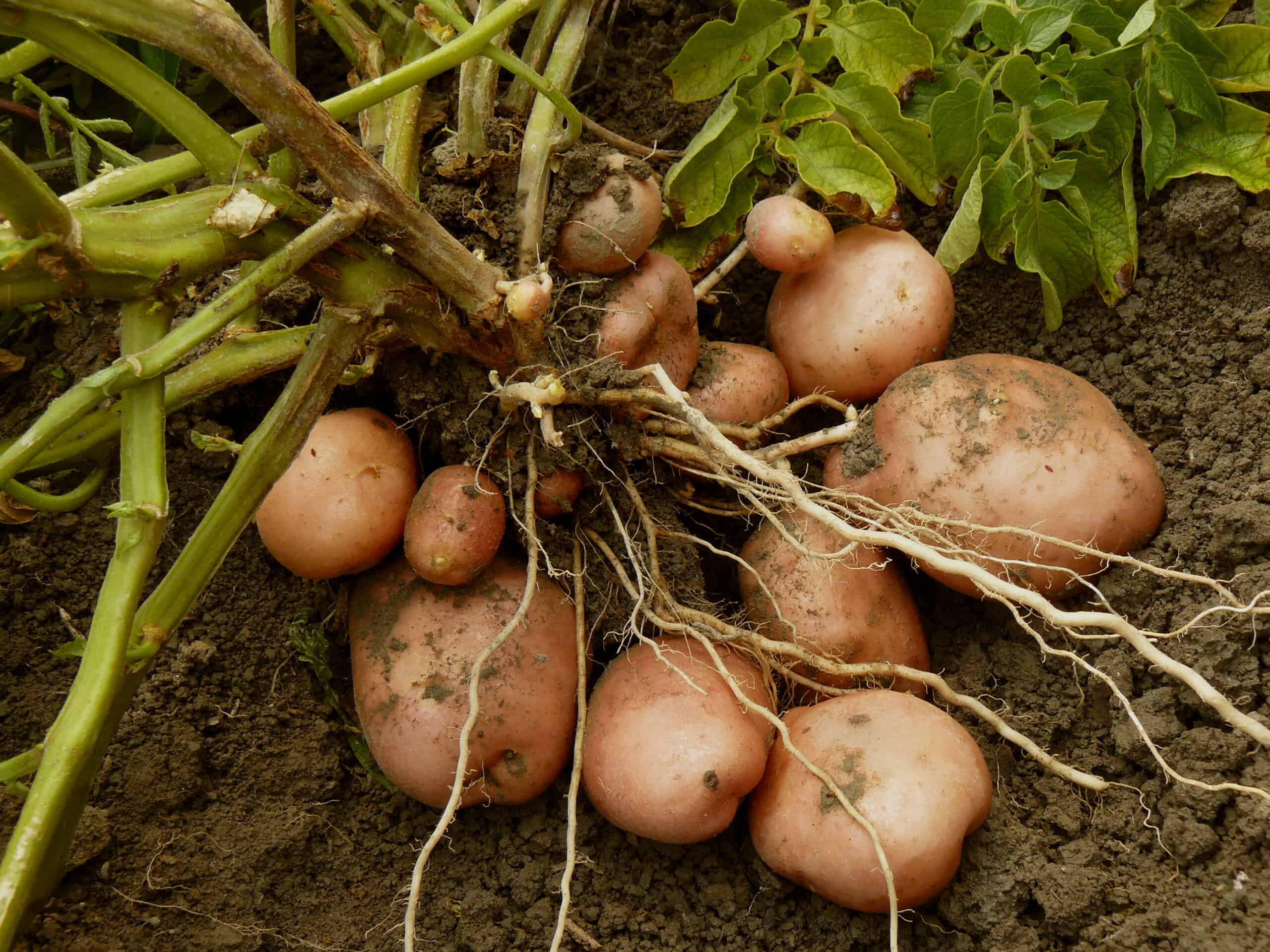
Get to know potatoes
- There are more than 3,000 varieties of potatoes. The potato is a perennial that is cultivated as an annual. It is a weak-stemmed plant with leaves similar in appearance to tomato leaves. The potato plant produces swollen tubers that grow underground from the plant’s roots. Potato tubers range from bite-size to about a pound (0.3 kg). Potatoes have been cultivated for as many as 7,000 years and they have changed history.
- Potatoes were used by sixteenth-century explorers to ward off scurvy as they circumnavigated the globe and discovered new lands. They were promoted as the “bread of the poor” in pre-revolutionary France, and the failure of the potato harvest in mid-nineteenth century Ireland started waves of immigration to Australia, Canada, and the United States.
- Potatoes are native to Peru. Spanish explorers brought them from the New World to the Old World. The Spanish word for potato is papa–that is also the original Peruvian name. The word potato is a corruption of the West Indian name batata.
- The popularization of the potato came at the urging of the eighteenth-century French agronomist Antoine-Augustin Parmentier. Parmentier persuaded Louis XVI to promote the cultivation of potatoes and introduced mashed potatoes served with butter.
- Today, Parmentier is a culinary term for dishes garnished or made with potatoes.
The botanical name of the potato is Solanum tuberosum.
Potato articles at Harvest to Table:
How to Plant and Grow Potatoes
6 Easy Steps to Grow Organic Potatoes
Grow Potatoes in Pots and Grow Bags: Seven Easy Steps
Seven Ways to Cook and Serve Potatoes
How to Cook New Potatoes with No Recipe
How to Make Seasonal and Flavorful Potato Salad
Yellow Potato Side Dish and Soup
Ham, Potato, and Cheese Gratin
Potato Growing Problems Troubleshooting
Colorado Potato Beetle Organic Pest Control
Articles of interest:
Best Herbs for Container Growing
Garden Planning Books at Amazon:
- Vegetable Garden Almanac & Planner
- Kitchen Garden Grower’s Guide Vegetable Encyclopedia
- Vegetable Garden Grower’s Guide
- Tomato Grower’s Answer Book
More kitchen tips:
Bring your harvest to the table. Kitchen prep tips and easy recipes for the vegetables you grow. Click below for vegetable prep and recipes you can use now.
- Almonds
- Apples
- Apricot
- Aprium
- Artichoke
- Arugula
- Asparagus
- Avocado
- Bamboo Shoots
- Banana
- Basil
- Beans, Dried
- Beans. Long
- Beans, Shell
- Beans, Snap
- Beets
- Bitter Melon
- Blackberry
- Bok Choy
- Broccoli
- Broccoli Raab
- Brussels Sprouts
- Cabbage
- Cardoon
- Carrots
- Cauliflower
- Celeriac
- Celery
- Chard
- Chayote Squash
- Cherimoya
- Cherries
- Chestnut
- Chickpea
- Chinese Cabbage
- Chives
- Cilantro
- Citron
- Clementine
- Collards
- Coriander
- Corn, Sweet
- Corn, Baby
- Corn Salad, Mache
- Cranberry
- Cress
- Cucumber
- Daikon
- Dandelion
- Dill
- Eggplant
- Endive, Belgian
- Endive and Escarole
- Fava Beans
- Fig
- Florence Fennel
- Garlic
- Ginger
- Grapefruit
- Grapes
- Guava
- Horseradish
- Jerusalem Artichoke
- Jicama
- Jujube
- Kale
- Kiwifruit
- Kohlrabi
- Kumquat
- Leeks
- Lemongrass
- Lemons
- Lettuce
- Lime
- Mache (Corn Salad)
- Mandarin Orange
- Mango
- Maple Syrup
- Marjoram
- Melons
- Michihili
- Mint
- Mizuna
- Mushrooms
- Mushrooms, Cremini
- Mustard Greens
- Napa Cabbage
- Nectarine
- Okra
- Olives
- Olive oil
- Onions
- Oranges
- Oregano
- Parsley
- Parsley Root
- Parsnips
- Passion Fruit
- Pawpaw
- Peaches
- Pears
- Peas, Garden Snap
- Peas, Snow
- Pei Tsai
- Peppers, Chili
- Peppers, Sweet
- Persimmon
- Pineapple
- Pineapple Guava
- Plantain
- Plums
- Pluots
- Pomegranate
- Potatoes
- Prickly Pear
- Pumpkin
- Quince
- Radicchio
- Radishes
- Raspberries
- Rosemary
- Rhubarb
- Rutabaga
- Sage
- Salsify
- Sauerkraut
- Savory
- Shallots
- Sorrel
- Spinach
- Squash, Summer
- Squash, Winter
- Strawberries
- Sunchokes
- Sunflower
- Sweet Potato
- Swiss Chard
- Tangerine
- Taro
- Tarragon
- Thyme
- Tomatillo
- Tomato
- Turnip
- Turnip Greens
- Yams















